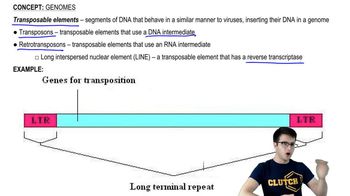Table of contents
- 1. Introduction to Biology2h 42m
- 2. Chemistry3h 40m
- 3. Water1h 26m
- 4. Biomolecules2h 23m
- 5. Cell Components2h 26m
- 6. The Membrane2h 31m
- 7. Energy and Metabolism2h 0m
- 8. Respiration2h 40m
- 9. Photosynthesis2h 49m
- 10. Cell Signaling59m
- 11. Cell Division2h 47m
- 12. Meiosis2h 0m
- 13. Mendelian Genetics4h 44m
- Introduction to Mendel's Experiments7m
- Genotype vs. Phenotype17m
- Punnett Squares13m
- Mendel's Experiments26m
- Mendel's Laws18m
- Monohybrid Crosses19m
- Test Crosses14m
- Dihybrid Crosses20m
- Punnett Square Probability26m
- Incomplete Dominance vs. Codominance20m
- Epistasis7m
- Non-Mendelian Genetics12m
- Pedigrees6m
- Autosomal Inheritance21m
- Sex-Linked Inheritance43m
- X-Inactivation9m
- 14. DNA Synthesis2h 27m
- 15. Gene Expression3h 20m
- 16. Regulation of Expression3h 31m
- Introduction to Regulation of Gene Expression13m
- Prokaryotic Gene Regulation via Operons27m
- The Lac Operon21m
- Glucose's Impact on Lac Operon25m
- The Trp Operon20m
- Review of the Lac Operon & Trp Operon11m
- Introduction to Eukaryotic Gene Regulation9m
- Eukaryotic Chromatin Modifications16m
- Eukaryotic Transcriptional Control22m
- Eukaryotic Post-Transcriptional Regulation28m
- Eukaryotic Post-Translational Regulation13m
- 17. Viruses37m
- 18. Biotechnology2h 58m
- 19. Genomics17m
- 20. Development1h 5m
- 21. Evolution3h 1m
- 22. Evolution of Populations3h 52m
- 23. Speciation1h 37m
- 24. History of Life on Earth2h 6m
- 25. Phylogeny2h 31m
- 26. Prokaryotes4h 59m
- 27. Protists1h 12m
- 28. Plants1h 22m
- 29. Fungi36m
- 30. Overview of Animals34m
- 31. Invertebrates1h 2m
- 32. Vertebrates50m
- 33. Plant Anatomy1h 3m
- 34. Vascular Plant Transport1h 2m
- 35. Soil37m
- 36. Plant Reproduction47m
- 37. Plant Sensation and Response1h 9m
- 38. Animal Form and Function1h 19m
- 39. Digestive System1h 10m
- 40. Circulatory System1h 57m
- 41. Immune System1h 12m
- 42. Osmoregulation and Excretion50m
- 43. Endocrine System1h 4m
- 44. Animal Reproduction1h 2m
- 45. Nervous System1h 55m
- 46. Sensory Systems46m
- 47. Muscle Systems23m
- 48. Ecology3h 11m
- Introduction to Ecology20m
- Biogeography14m
- Earth's Climate Patterns50m
- Introduction to Terrestrial Biomes10m
- Terrestrial Biomes: Near Equator13m
- Terrestrial Biomes: Temperate Regions10m
- Terrestrial Biomes: Northern Regions15m
- Introduction to Aquatic Biomes27m
- Freshwater Aquatic Biomes14m
- Marine Aquatic Biomes13m
- 49. Animal Behavior28m
- 50. Population Ecology3h 41m
- Introduction to Population Ecology28m
- Population Sampling Methods23m
- Life History12m
- Population Demography17m
- Factors Limiting Population Growth14m
- Introduction to Population Growth Models22m
- Linear Population Growth6m
- Exponential Population Growth29m
- Logistic Population Growth32m
- r/K Selection10m
- The Human Population22m
- 51. Community Ecology2h 46m
- Introduction to Community Ecology2m
- Introduction to Community Interactions9m
- Community Interactions: Competition (-/-)38m
- Community Interactions: Exploitation (+/-)23m
- Community Interactions: Mutualism (+/+) & Commensalism (+/0)9m
- Community Structure35m
- Community Dynamics26m
- Geographic Impact on Communities21m
- 52. Ecosystems2h 36m
- 53. Conservation Biology24m
19. Genomics
Genomes
Problem 4`
Textbook Question
Below are the amino acid sequences (using single letters; see Figure 5.14) of three short segments of the FOXP2 protein from five species. These segments contain all amino acid differences between the FOXP2 proteins of these species. Compare the amino acid sequences by answering parts (a)–(d).
Chimpanzee: PKSSD ... TSSTT ... NARRD
Mouse: PKSSE ... TSSTT ... NARRD
Gorilla: PKSSD ... TSSTT ... NARRD
Human: PKSSD ... TSSNT ... SARRD
Rhesus monkey: PKSSD ... TSSTT ... NARRD
Circle the names of any species that have identical amino acid sequences for the FOXP2 protein.
a. Chimpanzee, Gorilla, Rhesus monkey
b. Human, Mouse
c. Chimpanzee, Human, Mouse
d. Rhesus monkey, Human, Gorilla
 Verified step by step guidance
Verified step by step guidance1
Identify the amino acid sequences provided for each species: Chimpanzee, Mouse, Gorilla, Human, and Rhesus monkey.
Compare the sequences segment by segment, starting with the first segment (PKSSD for Chimpanzee, Gorilla, Human, and Rhesus monkey; PKSSE for Mouse).
Move to the second segment and compare: TSSTT for Chimpanzee, Mouse, Gorilla, and Rhesus monkey; TSSNT for Human.
Finally, compare the third segment: NARRD for Chimpanzee, Mouse, Gorilla, and Rhesus monkey; SARRD for Human.
Circle the species with identical sequences by checking if all three segments match exactly. In this case, Chimpanzee, Gorilla, and Rhesus monkey have identical sequences.
 Verified video answer for a similar problem:
Verified video answer for a similar problem:This video solution was recommended by our tutors as helpful for the problem above
Video duration:
1mPlay a video:
Was this helpful?
Key Concepts
Here are the essential concepts you must grasp in order to answer the question correctly.
Amino Acid Sequence
An amino acid sequence is the order of amino acids in a protein, which determines the protein's structure and function. Each amino acid is represented by a single letter code, and variations in the sequence can lead to differences in protein function across species. Understanding these sequences is crucial for comparing proteins like FOXP2 among different organisms.
Recommended video:
Guided course

Amino Acids
Protein Function and Evolution
Proteins like FOXP2 play specific roles in biological processes, and their sequences can evolve over time, leading to functional changes. Comparing sequences across species helps identify evolutionary relationships and functional conservation or divergence, which is essential for understanding how proteins contribute to species-specific traits.
Recommended video:
Guided course

Membrane Protein Functions
Species Comparison
Species comparison involves analyzing genetic or protein sequences to identify similarities and differences. This process helps determine evolutionary relationships and functional conservation. In the context of FOXP2, comparing amino acid sequences across species can reveal which species have identical sequences, indicating potential conservation of function.
Recommended video:

Biological Species Concept

 5:30m
5:30mWatch next
Master Genomes and Genome Evolution with a bite sized video explanation from Jason
Start learningRelated Videos
Related Practice


































